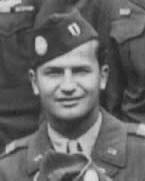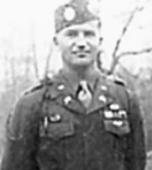Ronald Speirs
Ronald Speirs | |
|---|---|
 Speirs in Austria, 1945. | |
| Nickname(s) | Sparky |
| Born | April 20, 1920 Edinburgh, Scotland |
| Died | April 11, 2007 (aged 86) Glasgow, Montana |
| Allegiance | |
| Service | |
| Years of service | 1942–1966 |
| Rank | |
| Unit | Dog Company/Easy Company, 2nd Battalion, 506th Parachute Infantry Regiment, 101st Airborne Division |
| Battles / wars | World War II Korean War |
| Awards | |
| Relations | -Marv (stepson) -Robert (son) |
| Other work | Governor of Spandau Prison, Red Army Liaison Officer |
Lieutenant Colonel Ronald C. Speirs (April 20, 1920 – April 11, 2007)[2] was a United States Army officer who served in the U.S. 101st Airborne Division during World War II. He was initially a platoon leader in Company either "C" or "B" ("Charlie" or "Baker" Company) of the 2nd Battalion of the 506th Parachute Infantry Regiment. Speirs was reassigned to "D" Dog Company prior to the Normandy Invasion. Later he was re-assigned to "Easy" Company, and would command "E" or "Easy" Company in Bastogne at the end of the Battle of the Bulge. Speirs also served in Korea where he commanded a rifle company, and later became the American Governor for Spandau Prison in Berlin. He achieved the rank of Captain while serving in the European Theater during World War II and retired as a Lieutenant colonel (United States). Speirs was portrayed in the television miniseries Band of Brothers by Matthew Settle. Speirs' life story was featured in the 2010 book A Company of Heroes: Personal Memories about the Real Band of Brothers and the Legacy They Left Us.[3]
Youth
Speirs was born in Edinburgh, Scotland in 1920 and spent his first few years there until he emigrated with his family to Boston, Massachusetts, USA, arriving on December 26, 1924. He grew up in Portland, Maine. He attended military training in high school, which led to a commission as a 2nd lieutenant in the infantry; Speirs then volunteered for the paratroopers. He served as a platoon leader with Dog Company at Camp Toccoa, Georgia and was shipped to England shortly before Operation Chicago.
Military service

Speirs parachuted into Normandy on June 6, 1944 (or D-Day) and quickly met with fellow troops after landing. He assembled a small group of soldiers to assist during the Brecourt Manor Assault, where he single-handedly captured the fourth 105 mm Howitzer.[4][5][6] Speirs' platoon spent the night of June 6 being shuffled in position with other platoons as the company was arranged for battle to begin early the next morning.[7] A rolling artillery barrage had been coordinated in support of the ground assault on the morning of June 7. To initiate the attack, artillery fire was adjusted back towards American lines before moving forward in increments. Speirs ordered his platoon to hold position until the fire was completed to prevent serious casualties and fratricide. One of his squad leaders ignored the orders due to fatigue and disorientation. After his order was ignored a second time, Speirs shot the sergeant between the eyes, then promptly reported the incident to the company commander, Captain Jerre S. Gross. Gross was killed in combat the next day and the incident was not pursued.[8]

Due to Easy Company's role as primary assault company, Dog Company did not see as much action as Easy. However, it still participated in many engagements during the war, and both Speirs and Dog Company were at Bastogne. When Easy Company's initial attack on the German-occupied town of Foy bogged down due to the poor leadership of its commander, 1st Lt. Norman Dike, battalion executive officer Captain Richard Winters ordered Speirs to relieve Dike of command.[9] The selection of Speirs was random; Winters later stated that Speirs was simply the first officer he saw when he turned around.[10][11][12] Speirs successfully took over the assault and led Easy Company to victory. During this battle, Lt. Dike had ordered a platoon to go on a flanking mission around the rear of the town.[13] To countermand this order, Speirs himself ran through the town and German lines (as this platoon had no radio), linked up with the other soldiers, and relayed the order.[11] Having completed this, he proceeded to run back through the German-occupied town. He was reassigned as commanding officer of Easy Company and remained in that position for the rest of the war. Of the officers who commanded Easy Company during the war, Speirs commanded the longest.[14]
Winters assessed Speirs as being one of the finest combat officers in the battalion. He wrote in his memoirs that Speirs had worked hard to earn a reputation as a killer and had often killed for shock value.[8] Winters stated that Speirs was alleged on one occasion to have killed six German prisoners of war and that the battalion leadership must have been aware of the allegations, but chose to ignore the charges because of the pressing need to retain qualified combat leaders. Winters concluded that in today's army, Speirs would have been court-martialed and charged with atrocities, but officers like Speirs were too valuable because they were not afraid to engage the enemy.
Although Speirs had enough points to go home after the end of the European Campaign, he chose to remain with Easy Company. Japan surrendered after the atomic bombings of Hiroshima and Nagasaki, before Speirs and Easy could be transferred to the Pacific Theater.
Post World War II
Speirs returned to England to find that his wife (the widow of a British soldier who had been reported dead) had returned to her first husband who had turned up alive as a German prisoner of war. She apparently retained ownership of all the spoils of war (i.e., silver platters, goblets, plates, and utensils gathered at different places throughout Europe like Haguenau or Kehlsteinhaus) that Speirs had sent home from his travels in Europe.[15]
Korean War
Speirs then returned to the United States and decided to remain in the army, serving in the Korean War, where he made one combat jump and commanded a rifle company until the war's end.
This section needs expansion. You can help by adding to it. (November 2010) |
Later years
Following Korea, Speirs attended a Russian language course in 1956 and was assigned as a liaison officer to the Red Army in Potsdam, East Germany. In 1958 he became the American Governor of the Spandau Prison in Berlin, where prominent Nazis such as Rudolf Hess were imprisoned.[16] During his time at Spandau, prisoner Albert Speer mentions in his book "Spandau: The Secret Diaries," of a "hard-nosed, irritating American Commandant". That man was later identified as Speirs. In 1962, Speirs was a member of the U.S. Mission to the Royal Lao Army.[16]
Although he did not normally attend the yearly Easy Company reunions, Speirs met with some Easy Company members several times and attended at least one reunion in 2001.[17]
Ronald Speirs died on April 11, 2007, in Valley County, Montana near Glasgow.
Medals and decorations
| Silver Star | |
| Bronze Star with 2 Oak Leaf Cluster | |
| Purple Heart with three Oak Leaf Clusters | |
| Presidential Unit Citation with one Oak Leaf Cluster | |
| American Campaign Medal | |
| European-African-Middle Eastern Campaign Medal with 3 service stars and arrow device | |
| World War II Victory Medal | |
| Army of Occupation Medal | |
| National Defense Service Medal with 1 service stars | |
| Croix de guerre with palm | |
| French Liberation Medal | |
| Korean Service Medal with 3 service stars | |
| Korea Defense Service Medal | |
| United Nations Korea Medal | |
| Vietnam Service Medal with 3 service stars | |
| Vietnam Campaign Medal | |
| Combat Infantry Badge 2nd Award | |
| Parachutist Badge with 3 combat jump stars |
References
- ^ DeAngelis, Frank. "Speirs' shadowbox". Retrieved 2009-10-12.
- ^ Social Security Death Index record
- ^ [1]
- ^ Ambrose, p.83
- ^ Winters, p.88
- ^ Guarnere and Heffron, p.69
- ^ Winters, p.186
- ^ a b Winters, p.187
- ^ Winters, p.176
- ^ Winters, p.185
- ^ a b Ambrose, p.209
- ^ HistoryNet interview with Dick Winters, p.6
- ^ Ambrose, p.208
- ^ Winters, p.272
- ^ Ambrose, p.287
- ^ a b Ambrose, p.301
- ^ 101st Airborne News website
Bibliography
- Ambrose, Stephen E. (1992). Band of Brothers: Easy Company, 506th Regiment, 101st Airborne from Normandy to Hitler's Eagle's Nest. Simon & Schuster. ISBN 9780743464116.
- Winters, Richard D., with Cole C. Kingseed (2006). Beyond Band of Brothers: The War Memoirs of Major Dick Winters. St. Martin's Press. ISBN 0425208133.
{{cite book}}: CS1 maint: multiple names: authors list (link) - Guarnere, William J., and Edward J. Heffron, with Robyn Post (2007). Brothers in Battle, Best of Friends: Two WWII Paratroopers from the Original Band of Brothers Tell Their Story. Berkley Caliber. ISBN 9780425219706.
{{cite book}}: CS1 maint: multiple names: authors list (link) - Brotherton, Marcus (2010). A Company of Heroes: Personal Memories about the Real Band of Brothers and the Legacy They Left Us. Berkley Caliber. ISBN ISBN 9780425234204.
{{cite book}}: Check|isbn=value: invalid character (help)
External links
- 1920 births
- 2007 deaths
- American military personnel of World War II
- American military personnel of the Korean War
- Band of Brothers characters
- Operation Overlord people
- People from Edinburgh
- Recipients of the Purple Heart medal
- Recipients of the Silver Star
- American people of Scottish descent
- Scottish emigrants to the United States
- United States Army officers
- People from Portland, Maine
